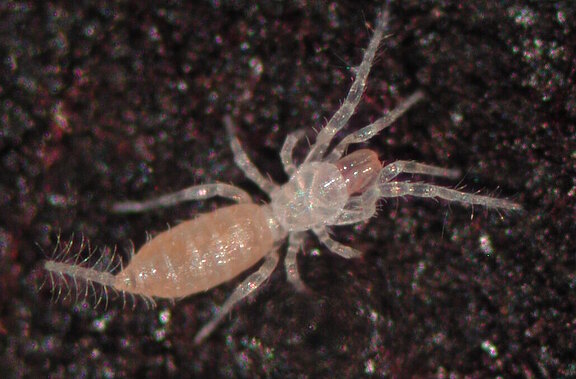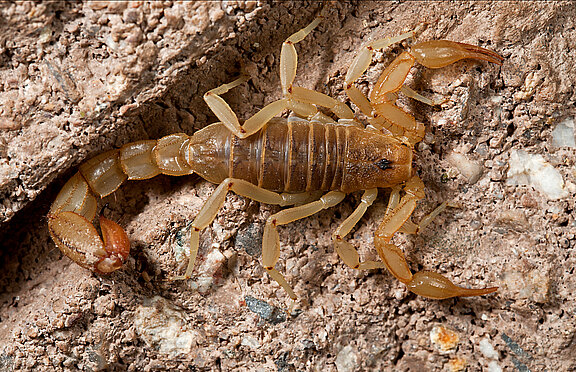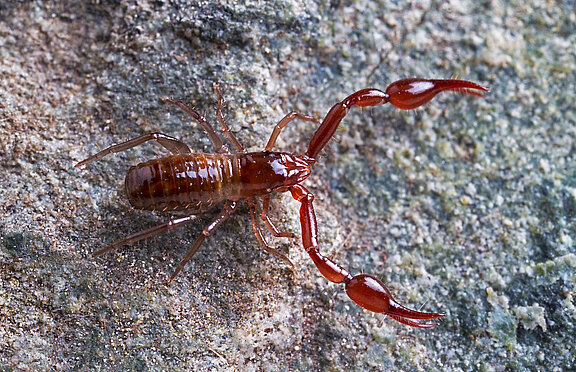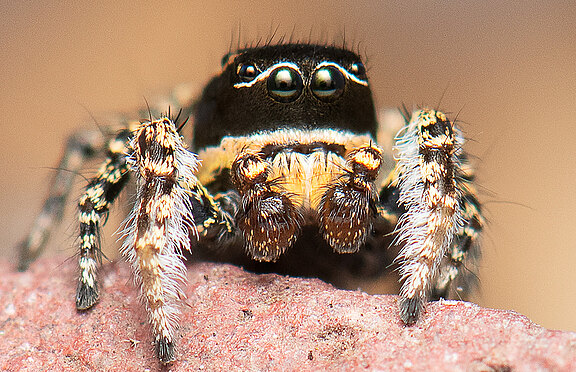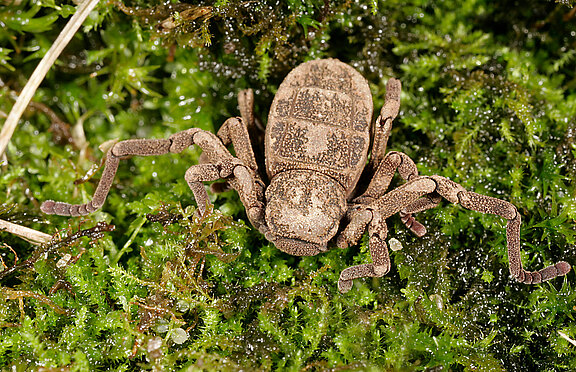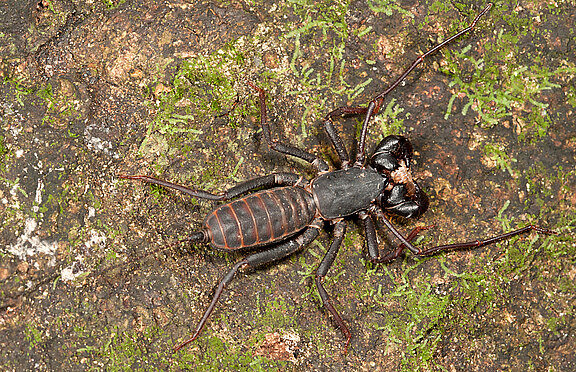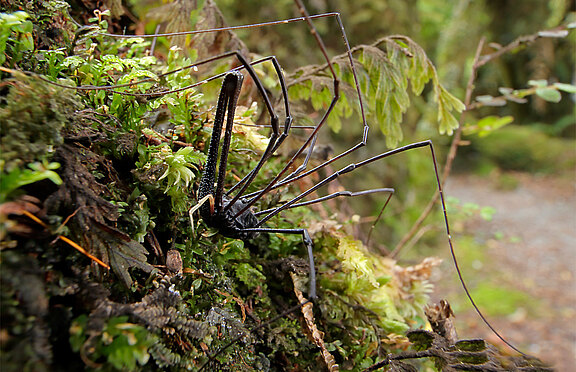List of all articles
Volume 52 Number 1
Electrophysiology, mechanoreceptor, sensilla, resolvability
Abstract
Scorpions possess midventral touch/taste organs called pectines, which may be important for learning the nuances of the substrate during navigation as well as the detection of pheromones, spermatophores, and food. The pectines possess thousands of minute structures called peg sensilla that are responsive to both chemicals and mechanical deflection of the peg shaft. While much is known about the chemical responsiveness of the pegs, very little is known about their mechanosensory properties. Here we ask if the peg mechanosensory response is “all-or-nothing” or graded depending on the intensity of stimulation. We made electrophysiological recordings of neural activity from individual peg sensilla while deflecting the peg to elicit apparent mechanosensory responses. Our records show the presence of a rapid firing (.100 Hz), quickly adapting waveform that is indicative of a mechanoreceptor and appears to be independent of previously identified chemo-responsive cells. We tested mechanosensory response dynamics in two ways. The first test focused on a shorter-duration touch versus a longer-duration touch, while the second focused on a smaller deflection versus a larger deflection. Both pairs of stimulations (short vs long touch; small vs large touch) produced repeatable and statistically distinct responses in terms of spiking frequency. These results indicate the mechanosensory responses of peg sensilla are graded, which sheds light on the textural resolvability of the pectines and informs models of the type of information that scorpions obtain while assessing surfaces in their environment.
Volume 52 Number 1
South Asia, cannibalism, copulation, habitat utilization
Abstract
Argiope anasuja Thorell, 1887 is a species of orb-weaving spider found in tropical and subtropical regions of the world. Despite its widespread distribution, little is known about its natural history and mating behavior. In this study, I describe some aspects of the natural history and mating behaviors of A. anasuja in captivity and in natural habitats. The spiders were found to occupy less shady areas close to water bodies, building their webs between 50 to 200 cm above the ground level. Web decorations were common in female webs, primarily in the central area, and consisted of dense zigzag bands of silk. A significant difference in copulation duration was observed between cannibalized and non-cannibalized individuals. Furthermore, a significant difference in copulation duration was found between individuals in natural environments and laboratory conditions. However, no significant difference was observed in courtship duration between individuals in natural environment and laboratory conditions. Understanding the mating behaviors of A. anasuja is important because they play a key role in determining the success of mating. This study highlights the natural history and mating behavior of A. anasuja, contributing to our understanding of this species in Sri Lanka.
Volume 52 Number 1
Tropical rainforest, low abundance, orb spiders, arthropod demographics, life cycles
Abstract
Globally, arthropod populations are declining at alarming rates, but the causes are rarely understood. Our research details and examines possible causes for fluctuations in the size of a Costa Rican population of golden silk orbweaver spiders (Trichonephila clavipes (Linnaeus, 1767)). Over a seven-year period from 2013–2019, we noted a sharp decline and then partial recovery of the study population during the wet season (June, July), but then failed to locate any spiders during a brief survey in June 2022 when they would otherwise be abundant. We monitored webs daily during 2013–2019 to test whether variation in prey capture, competitors, female size, male availability, predation, temperature, or rainfall related to population fluctuations. We were unable to explain T. clavipes population trends with the collected data. Future studies are needed to determine whether the extremely low population densities we witnessed in 2017 and 2022 can be interpreted as the lowest values of this species' normal population fluctuation cycle or whether these extremes are part of a long-term spider decline.
Volume 52 Number 1
Mating, reproduction, matriphagy, sociality, life history
Abstract
Organisms can optimize their reproductive success by differential resource allocation. When adult survival is low, investment of all resources into a single reproductive event can be beneficial, favouring a semelparous strategy. In the spider genus Stegodyphus Simon, 1873 (Eresidae), all species are considered semelparous, based on observations of ancestral subsocial species. However, derived social species show task differentiation and helping by non-reproducing females. This could facilitate a facultative iteroparous strategy by providing sufficient resources to meet the threshold for repeated reproduction. We investigated the reproductive behaviour of groups with single breeding females in the cooperative breeding Stegodyphus dumicola Pocock, 1898. We found that mothers can depart from a strictly semelparous lifestyle by producing more than one clutch. The facultative iteroparity in S. dumicola may enhance colony growth and survival, and act as a mechanism to maintain sociality.
Volume 52 Number 1
Dietary breadth, diet composition, food webs
Abstract
The overall assumption that scorpions are generalist predators is often based on conspicuous information from the literature. Here, we compiled a list of prey consumption by scorpions from different environments in Brazil to produce a documentation of predations by this taxon. This list is based on observations made under natural conditions in Atlantic Forest, Caatinga, and Cerrado formations. We compiled 135 predation instances including 11 scorpion species from field work through 14 years. The observed diet composition of the scorpions was mainly based on cockroaches, crickets, grasshoppers, spiders, and other scorpions. Such data highlights the generalist diet and cannibalism of scorpions with many cannibalistic events among the records of intraguild predation. Overall, this study broadens the knowledge of the diet composition of Brazilian scorpions under natural conditions.
Volume 52 Number 1
Araneae, morphology, Stirling Range, biodiversity hotspot, taxonomy
Abstract
Taxonomic studies have evolved greatly since their early stages and new techniques have been incorporated to improve species descriptions. Those involving the comparison of traits, either quantitatively or qualitatively, can be difficult because the identification of a species must rely on the experience of the observer and errors can occur when cryptic species are involved. Molecular methods have been used to fill these gaps, but morphological methods are still needed to match the recognized molecular species with an adequate taxonomic description. Focusing on the trapdoor spider genus Proshermacha Simon, 1908, we provide a case study using Geometric Morphometrics (GM) techniques to identify morphological divergence between species found in the south-western Australia region. We used GM to identify morphological divergence from museum-preserved specimens by examining shape variation of sexual characters from 39 male specimens from five different localities on a single mountain range. Variation in the shape of both the palpal bulb and tibia provided strong evidence to distinguish two morphotypes, while metatarsus shape showed fewer between-locality differences. Our results illustrate the utility of GM methods, when applied to a few taxonomically-informative structures, as a quantitative species delimitation tool for taxonomic studies.
Volume 52 Number 1
development, molting, Palpimaninae, Palpimanoidea, spinning apparatus
Abstract
As in other Palpimanidae, two pairs of posterior spinnerets present in typical Araneomorphae are vestigial in Palpimanus uncatus Kulczyński, 1909, with only the anterior lateral spinneret (ALS) pair prominent. Nevertheless, in late juvenile and adult females, spigots appear in the ancestral posterior spinneret region (PS). Consistent with these spigots serving cylindrical silk glands, females construct substantial egg sacs. While juveniles and adults exhibit a compressed PS, in postembryos it is fully extended. Piriform silk gland (PI) spigots form a linear array on ALSs from the 1st stadium, increasing in number during ontogeny by addition of PIs of the tartipore-accommodated (T-A) subtype (i.e., functional during proecdyses). The number of T-A PIs added from one stadium to the next and locations occupied by their spigots often exhibit a stereotypic pattern, especially consistent in early instars. The number of non-T-A PIs remains constant through ontogeny from the 1st stadium: one per ALS rather than the two per ALS inferred in a few araneoids. The secondary major ampullate silk gland (2° MaA) spigot, primitively uni-shafted among araneomorphs, has become modified into a multi-shafted spigot with extended base, the number of shafts increasing during ontogeny. However, the multiple ducts that connect to the shafts continue to be accommodated during proecdysis by a single enormous tartipore. Sexual dimorphism is present, with late stadium females having greater numbers of T-A PI spigots and 2° MaA spigot shafts. Observations are presented pertaining to feeding behavior, sexual cannibalism (absent), habitat, winter diapause, numbers of molts, and longevity.
Volume 52 Number 1
Novomessor, Myrmecicultor, Pogonomyrmex, myrmecophile, symbiont
Abstract
The spider, Myrmecicultor chihuahuensis Ramírez, Grismado & Ubick 2019 is a myrmecophage. In an earlier study, we found that the spider's cuticular hydrocarbon (CHC) profile overlapped with that of its prey. In the present study, we photographed nests of Novomessor ants to determine whether these spiders live inside the ant nest with their prey or in the vicinity of the colony. We set up two 35 mm cameras over two main entrances of one nest of N. albisetosus (Mayr 1886) such that images would be captured of the ant colony surface (including the entrances) every 15 – 60 sec over five consecutive nights. These images included five showing M. chihuahuensis directly at one of the nest entrances investigating dead ants. The spider was not seen away from the entrance. This study provides evidence suggesting that this myrmecophage may live inside the colony with the ants it eats.
Volume 51 Number 3
Phidippus regius, Salticidae, spider, red light, visible spectrum
Abstract
Jumping spiders (Araneae: Salticidae) possess a visual system that is exceptional among arthropods, mainly due to its unmatched acuity. Although vision of these spiders has been studied for decades, some of its main aspects remain unclear. One such aspect is the light spectrum visible to salticids, which is surprisingly heterogenous and involves various underlying physiological mechanisms. The results of the behavioral experiments with the regal jumping spider (Phidippus regius) presented in this study provide evidence that these vision-dependent spiders are able to capture their prey even under red (longwave) light, which is usually not perceived by spiders. Broader use of this experimental design in studies of spider vision is discussed.
Volume 51 Number 3
Scorpiones, fossil, Emsian, Scotland, sensory organ, pectines
Abstract
A cuticle fragment found in an Early Devonian (Emsian) macerate from the Strathpeffer–Struie outlier in the Northern Highlands of Scotland represents the isolated pectinal tooth of a scorpion. This remarkable find includes a distinctive field of small projections in rounded sockets consistent with the peg sensilla of extant scorpions. This is the oldest evidence for the presence of these characteristic sensory organs, which in modern scorpions play an important role in chemo- and mechanoreception. The fossil indicates that some scorpions had developed anatomically modern pectinal teeth at least 395 million years ago, suggesting that the pectines of these early scorpions played a similar role, physiologically and behaviorally, to those of living species.
Volume 51 Number 3
spider, type specimens, Andes, South America, diversity
Abstract
Eleven new species from the Scytodoidea group are described from mainland Ecuador: in the family Drymusidae, Drymusa pristirana sp. nov. (female) and in the family Scytodidae, Scytodes amazonica sp. nov. (male, female); S. argelia sp. nov. (female), S. ayampe sp. nov. (female), S. choco sp. nov. (male, female), S. costa sp. nov. (female), S. jaguar sp. nov. (male), S. loja sp. nov. (female), S. minus sp. nov. (male); S. orellana sp. nov. (male, female); and S. tayos sp. nov. (male). The new species D. pristirana sp. nov. presents a unique morphological character on the ventral surface of the female abdomen. The type specimens of S. lineatipes Taczanowski, 1874 from French Guiana and S. luteola Simon, 1893 from Venezuela are imaged for the first time, and S. romitii Caporiacco, 1947 is removed from synonymy with S. lineatipes.
Volume 51 Number 3
Avicularioidea, biogeography, Nemesiidae, Nemesioidina, taxonomy
Abstract
The open-holed trapdoor spiders of the Teyl damsonoides-group (formerly included in the now synonymized genus Merredinia Main, 1983) are revised, and 20 new species are described from the biodiversity hotspot of south-western Western Australia. The only previously described species, T. damsonoides (Main, 1983), is further re-described and re-illustrated, and molecular data from seven genes for a subset of nine species are analyzed using Bayesian methods. The damsonoides-group of Teyl are unusual for their stunning bi-colored appearance and the bowed morphology of the male metatarsus I, and we here document the known diversity and biology of these little-known spiders.
Volume 51 Number 2
BugGuide, community scientist, harvester, harvestmen, iNaturalist
Abstract
Community science has contributed significantly to biodiversity and conservation related research. iNaturalist is a popular community science application, where community-submitted photo documentation of observed taxa has led to a large natural history database. Here, we present results of an iNaturalist project focusing on documenting Opiliones introduced to the USA and Canada. Including all observations made in this project up through 31 December 2021, there were 849 total observations (486 research grade), which included 16 introduced species (excluding multiple species of uncertain status), 11 of which were newly recorded for the USA and Canada. We provide an updated checklist of introduced species, including updated distributions for previously recorded species. This research was facilitated by the community science platform iNaturalist, which allows easy interactions between scientists of all types.
Volume 51 Number 2
Temporal variation, strategic signaling, pheromone quantification, gas chromatography-mass spectrometry
Abstract
Female chemical signals are crucial for sexual communication in spiders and convey detailed information about females' mating status or age. However, evidence for chemical communication in spiders is largely behavioral. Only a few spider pheromones are known and quantitative chemical analyses of individual spiders are especially scarce. In the European wasp spider, Argiope bruennichi (Scopoli, 1772), females emit the volatile trimethyl methylcitrate, which attracts males from a distance. A recent study on the role of this pheromone in close-range male mate choice revealed that older virgin females approaching oviposition produce higher amounts of pheromone than younger ones, thereby increasing their attractiveness to males, and stop pheromone signaling shortly after copulation. Here we provide more detailed analyses of temporal dynamics in pheromone production in both virgin and mated female A. bruennichi. Our results corroborate previous observations indicating that male mating behavior in this species is guided by variation in female signaling effort.
Volume 51 Number 2
French Guiana, pitfall trap, phototaxis, diameter effect.
Abstract
Patterns of phototaxis are incompletely characterized in arachnids and hardly generalizable because of large variations in orders, families, species, environments, and methods employed. In a neotropical forest of French Guiana, we tested the effect of both light and diameter on pitfall trap catches. Light had a significant effect on capture rates of all arachnids and on Araneae alone, with more individuals caught in lit traps. Without light, pitfall diameter had no effect on capture rates, while in lit traps, significantly fewer individuals were captured only in smaller traps. Light trapping is thus a promising tool to complete inventories in tropical forests. This field experiment calls for further studies of the mechanisms by which arachnids are attracted by light, especially by unraveling an actual phototaxis from indirect effects like prey attraction.
Volume 51 Number 2
Survival, specialist, diet, fitness, ontogenesis
Abstract
Specialists possess specialized trophic adaptations. Spiders of the genus Palpimanus Dufour, 1820 are araneophagous spiders which also catch alternative prey. They have morphological, behavioral, and venomic adaptations tuned to higher efficacy in the capture and processing of other spiders. Here, we tested the hypothesis whether Palpimanus can develop on two prey types. We reared spiderlings of Palpimanus spp. on a diet composed of spiders and of insects, and recorded their performance. We found that Palpimanus exhibited significantly higher mortality on the insect diet. In fact, only spiderlings on the spider diet were able to develop. The developmental rate was slow, as one instar lasted on average more than 60 days. On the basis of this finding, we estimated that the life cycle is at least biennial. We conclude that Palpimanus spiders possess specialized prey-capture adaptations towards spider prey which prevent them to utilize alternative prey.
Volume 51 Number 2
Arachnida, hydric stress, ecophysiology, water deficit
Abstract
Water conservation is one of the major challenges encountered by terrestrial arthropods; species inhabiting dry forests are hypothesized to have adapted to dry conditions. Tityus pusillus Pocock,1893 is one of the most abundant scorpion species in northeastern Brazil, occurring in dry and tropical rainforests. Considering the wide distribution of T. pusillus, we aimed to investigate differences in desiccation resistance between populations originating from the Atlantic rainforest and the Caatinga dry forest. In this study, 40 individuals of T. pusillus from each of the two ecosystems were used. The two groups were separated into control and treatment groups (individuals without a water supply). Scorpions from the Atlantic rainforest had a shorter lifespan than those from the Caatinga dry forest, both in the control and treatment groups. However, the weight loss rate was higher in scorpions from the Caatinga dry forest than those from the Atlantic rainforest. In addition, Atlantic rainforest scorpions presented a lower resistance to desiccation, exhibiting a higher mortality rate than the Caatinga dry forest individuals. These results suggest that T. pusillus can exhibit, via phenotypic plasticity or local adaptation, a broad range of tolerances that allow it to persist in different habitats. Furthermore, our findings suggest that T. pusillus individuals from the Caatinga dry forest have physiological attributes that allow them to resist prolonged desiccation, which may be related to adaptations that are intrinsic to the population from the dry forest.
Volume 51 Number 2
Allometric growth, Italy, nymphal instars, sexual dimorphism, trichobothria
Abstract
Pseudoscorpions are arachnids featuring three nymphal instars before reaching the adult age. Instars can be mostly recognized based on the number of trichobothria which lie along the chelal axis: as the individual grows, further trichobothria are added. The study of the post-embryonic growth based on trichobothria position has been the most widely used approach. However, other body parts can be subjected to particular growth patterns that need to be explored to fully understand post-embryonic development processes. Rigorous numerical approaches that allow meaningful statistical inference within growth regressions are now available. The recently described Mediterranean species Geogarypus italicus Gardini, Galli & Zinni, 2017 gave the authors the chance to review studies carried out in the past with the modern statistical approach mentioned above. Results confirm the main hypothesis about the growth process of the chelal axis but showed some differences that may be related to taxonomical aspects. Moreover, the study of body allometry during postembryonic growth showed that not all body parts undergo the same trend from protonymphs to males, on one side, and to females, on the other. Finally, the study of proportions between body parts through the analysis of ratios between their linear measurements pointed out a marked sexual dimorphism of pedipalps in spite of similar sizes and proportions of other body regions. The analysis led us to think that more interesting information could come from applying this approach to multispecies studies.
Volume 51 Number 2
Multimodal communication, sexual selection, chemical ecology, predator-prey interaction, sensory ecology.
Abstract
The largest family of spiders, jumping spiders (Salticidae), is known for performing complex visually mediated predatory and courtship behavior. As cursorial predators, they rely on their sensory systems to identify objects at a distance. Based on these assessments, salticids perform flexible and target-specific behavioral sequences which demonstrate a high level of cognitive processing. Recent studies have highlighted the role of other sensory modalities in these processes, such as chemoreception and mechanoreception, and elucidated the visual cues used for object identification, including motion, color, contrast, and shape-based cues. Until recently, sensory modalities other than vision were largely overlooked, but current advances in technology now allow us to probe their sensory and cognitive capabilities, as well as how these are shaped by experience. In this review, I provide an overview of current knowledge of salticid behavior and the sensory systems underpinning this behavior, and highlight areas in need of further research. This review focusses on our understanding of salticid communication, parental behavior, personality, antipredator behavior, and diet, as well as habitat selection. I argue that a historical vision-based focus on a small number of species due to their coloration or their unusual behavior provides a springboard for a deeper understanding of the general cognitive and sensory attributes that have evolved in this lineage, of which we yet have much to learn.
Volume 51 Number 2
pseudoscorpion, taxonomy, identification key, China.
Abstract
Twenty new species of the genus Bisetocreagris Ćurčić, 1983 are described from caves in the provinces of Guizhou (B. baiyunensis sp. nov., B. baimensis sp. nov., B. bangenensis sp. nov., B. daxingensis sp. nov., B. diaojiangensis sp. nov., B. dongjiensis sp. nov., B. duolangpingensis sp. nov., B. ganxiaoensis sp. nov., B. guanyinensis sp. nov., B. matuoensis sp. nov., B. sanhensis sp. nov., B. shahensis sp. nov., B. shangshanensis sp. nov. and B. yaolinensis sp. nov.), Yunnan (B. mahnerti sp. nov. and B. tuanjiensis sp. nov.), Sichuan (B. tianyangensis sp. nov.), Chongqing (B. xianduhensis sp. nov.), Hubei (B. changchaoensis sp. nov.) and Guangxi (B. xiniuyanensis sp. nov.). An identification key is provided to all known Chinese cave-inhabiting representatives of the genus Bisetocreagris.
Volume 51 Number 2
Non-native species, introduced species, invasive arthropods, citizen science, geographic distribution, range expansion
Abstract
Introductions of non-native species to novel environments happen often, but a species must overcome multiple biotic and abiotic filters to establish and eventually spread. Focusing on patterns of introductions can provide insights as to underlying mechanisms that facilitate establishment, and in turn, their potential effects on native communities. The brown widow spider, Latrodectus geometricus C. L. Koch, 1841, is likely native to Africa, but now has a cosmopolitan distribution due to introductions via international trade. We reviewed the patterns of brown widow introductions in the Americas to determine if there are any large-scale inferences regarding their patterns, and potential impacts, of their introduction. A total of 5,004 records from 30 countries were synthesized and demonstrate their spread to higher latitudes across time with the majority of those records (n = 4,923; 98%) occurring in the past two decades. Brown widows are now documented in 30 of the 35 countries in North, Central, and South America, with one-third of those introductions detected in the last 30 years. Citizen-science databases (e.g., iNaturalist) have been instrumental in documenting the expansion of the brown widow, as more than 90% of the records synthesized came from these sources. Brown widows have proven to be successful invaders worldwide, and this review synthesizes expansion reports of their invasion in the Americas in hopes of spurring additional research in locations where they have become established.
Volume 51 Number 2
courtship behavior; mound-building; Greater Mountains
Abstract
In this study, I provide the first description of mating behavior in the field for the genus Castianeira Keyserling, 1879 (Araneae: Corinnidae). Females have been observed building intricate mounds over their egg sacs; this study describes mating behavior while the female was building a mound—suggesting that females may have more than one clutch of offspring during the mating season or that she may store sperm for the next mating season. Analysis of my field footage and observational data revealed a simple mating behavior with little pre-or post-copulatory interaction. I compared my observations with laboratory observations by Montgomery (1909) of Castianeira descripta (Hentz, 1847) and Castianeira longipalpa (Hentz, 1847). The mating behaviors are similar in length but the sequence and duration of coupling differed. These observations create a starting point for better researching courtship and mating behavior of this spider, the number of egg sacs produced during a season, as well as the role of mound-making in the reproduction process.
Volume 51 Number 2
Cave-dwelling spiders, conservation, niche segregation, subterranean habitats, lava caves
Abstract
Meta menardi (Latreille, 1804) and M. bourneti Simon, 1922 (Araneae: Tetragnathidae) are ubiquitous inhabitants of the twilight zone of most hypogean sites across Europe. Recent observations in volcanic caves pointed out the presence of both species in Sicily, with M. menardi occurring in a small number of caves. On the basis of field investigations conducted in 2017–2021, we analyzed the distribution and the habitat frequency of the two species along the altitudinal gradient of Mount Etna. Our results demonstrate a significant effect of climate and altitude on the segregation of the two species, with M. menardi occurring exclusively above 1200 meters in caves opening in areas characterized by low temperatures (mean ± SD = 10.1 ± 0.688C) and high precipitations (682 ± 19 mm). Conversely, M. bourneti preferably occurred in areas with higher temperatures (14.5 ± 2.18C) and lower precipitations (606 ± 46 mm). Substrate age was not affecting the distribution of the two species, as both occurred in volcanic caves of ancient and recent formation (from 350 to .1,000 years). In light of the ongoing global warming, a possible increase in temperature could favor the upshift of M. menardi towards upper areas on the volcano subjected to high volcanic disturbance and thus unsuitable for hosting stable populations through time. In this regard, investigations on the response of Meta spiders to increases in temperature on the Etna volcano would be an asset to establish an appropriate management plan for the conservation of the newly discovered population of M. menardi in Sicily.
Volume 51 Number 2
Body size, orb web construction, measurement techniques, Araneidae
Abstract
Spider webs, and in particular orb webs, are among the most iconic characteristics of spider biology. The evolution of, and developmental changes in, orb webs have been well studied, but we still have a limited understanding of allometric relations between the size of orb webs and spider body size. In this study, we investigate this relationship using measurements from 55 individuals of two common orb-weaving spider (Araneidae) species in South Wales, UK. We recorded body size using two methods: direct measurements with calipers, and estimations from photographs using ImageJ software. We found that these two methods give almost identical measurements, supporting the use of image-based size measurement in many situations where this is advantageous. We also found evidence for negative allometry of orb web size (relative to spider body length), such that larger spiders build proportionately smaller webs. This implies that the ‘giant webs’ in some orb-weaver species must be the result of a fundamental shift in the constraints or advantages which result in the allometric relationships described here.


